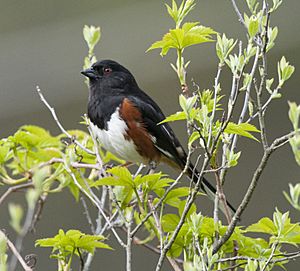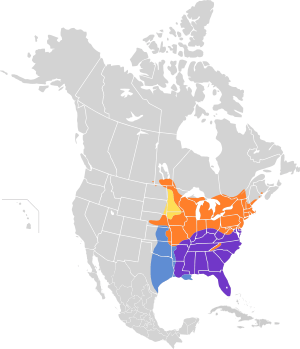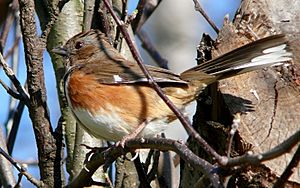Eastern towhee facts for kids
Quick facts for kids Eastern towhee |
|
|---|---|
 |
|
| Male in Massachusetts, US | |
| Conservation status | |
| Scientific classification | |
| Genus: |
Pipilo
|
| Species: |
erythrophthalmus
|
 |
|
| Synonyms | |
|
Fringilla erythrophthalma Linnaeus, 1758 |
|
The eastern towhee (Pipilo erythrophthalmus) is a cool bird that belongs to the New World sparrow family. It's a fairly large bird. For a while, scientists thought the eastern towhee and the spotted towhee were the same species, calling them the "rufous-sided towhee." But now, they are considered different birds.
These birds like to live in brushy areas across eastern North America. They build their nests low in bushes or right on the ground under shrubs. If they live in the northern parts, they will migrate south for the winter. Once, an eastern towhee even flew all the way to Great Britain in 1966!
You can often hear the eastern towhee singing "drink your teeeeea". It's a quick song, about one second long. It starts with a sharp "drink!" and ends with a trill "teeeeea". The name "towhee" sounds like another one of their common calls, which rises in pitch. Some people also call this sound a "chewink."
Contents
About the Eastern Towhee
What's in a Name?
The eastern towhee was first described by a Swedish scientist named Carl Linnaeus in 1758. He gave it the scientific name Fringilla erythrophthalma. Later, it was moved to the group of birds called Pipilo. The name erythrophthalmus comes from old Greek words meaning "red" (eruthros) and "eye" (ophthalmos). This makes sense because many eastern towhees have red eyes!
There are four main types, or subspecies, of eastern towhees:
- P. e. erythrophalmus: Found from south-central and southeast Canada down to the eastern United States.
- P. e. canaster: Lives in the interior southeast United States.
- P. e. rileyi: Found along the coastal southeast United States, but not in central and southern Florida.
- P. e. alleni: Lives in south and central Florida.
What Do They Look Like?
The eastern towhee is a striking and large sparrow. They are usually about 17.3 to 23 cm (6.8 to 9.1 in) long, and their wings can spread 20–30 cm (7.9–11.8 in) wide. They weigh about 32 to 53 g (1.1 to 1.9 oz).
Adult eastern towhees have reddish-brown (called rufous) sides and a white belly. Their long tail is dark with white edges. Most have bright red eyes, but some in the southeast have white eyes.
- Males have a black head, upper body, and tail.
- Females have brown in those same areas instead of black.
- Young birds (juveniles) are mostly brown all over.
It's usually easy to tell an eastern towhee apart from other birds. They don't usually live in the same places as the similar spotted towhee.
Where Do They Live?
Eastern towhees live all over the eastern United States and southeast Canada. You can find them from southern Saskatchewan, southwest Ontario, and Quebec down to Florida, and west to eastern Texas.
Birds that live in the northern areas, like southern New England or northern Indiana and Illinois, usually stay there only during the summer. The Pipilo e. erythrophthalmus subspecies is the one that migrates the most, flying south for the winter. The other subspecies tend to stay in the same area all year.
Eastern towhees like places where the land has been disturbed, like old fields or shrubby areas along power lines. They prefer places with lots of bushes and shrubs, like blackberry and blueberry plants.
Sadly, from 1966 to 2015, the number of eastern towhees decreased by more than 1.5% each year along the Atlantic seaboard and in the northern parts of their breeding range.
Life of an Eastern Towhee
When Do They Arrive and Leave?
Eastern towhees arrive at their summer homes at different times depending on the location. In New York, they usually arrive in early April and leave by mid-November. In New Hampshire, they arrive in late April or May and mostly leave in September. Further south, near Tennessee and North Carolina, they start moving to higher mountains as early as March and leave in October.
Nesting and Raising Young
Eastern towhees start breeding in spring and continue until late summer. They can begin nesting as early as late March in Florida and Georgia, or in mid-May in northern New England.
The female builds the nest, which takes about three to five days. They lay eggs until about August. For example, in Indiana, nesting happens from April 15 to August 20. If a nest fails, they might try to build another one. They can raise two, and sometimes even three, groups of young birds (broods) in one season.
Eastern towhees usually stay in their breeding areas. Some birds have been seen returning to the same spot for up to five years in a row!
A female eastern towhee usually lays between 2 and 6 eggs. She sits on the eggs (incubates them) for 12 or 13 days. After the chicks hatch, both parents feed them. The young birds leave the nest (fledge) about 10 to 12 days later. They still depend on their parents for about another month.
Many things can cause nests to fail, especially predators. But adult towhees usually live a long time. Some eastern towhees have been known to live for over 12 years in the wild! Both males and females can start having babies when they are two years old.
Where Eastern Towhees Live and Eat
Preferred Homes
Eastern towhees live in many different places, from near sea level up to 6,500 ft (2,000 m) high in the mountains. They spend most of their time close to the ground. For example, in Pennsylvania, they are often seen less than 3 ft (0.91 m) off the ground.
They can be found in tall grasslands, marshes, and even old forests. However, they are most common in areas that are just starting to grow back after being disturbed, like clearings or the edges of forests. They love places with lots of dense bushes and shrubs.
Studies show that eastern towhees are more common in younger forests or areas where trees have been cut down recently. They like places with open canopies (not too many trees blocking the sun) and thick undergrowth (bushes and plants close to the ground).
They also seem to like certain plants. In Iowa, they were found more often where there were many different types of plants and vines. In West Virginia, they liked drier areas with plants like blackberry and black cherry.
Where They Build Nests
Eastern towhees almost always build their nests on or very close to the ground. Most nests are found less than 5 feet (1.5 m) high. Nests built higher up tend to be less successful.
They build nests in many different plants, including grapevines, blueberry bushes, and oak trees. Ground nests are usually hidden in leaf litter at the base of grasses, small shrubs, or tiny trees.
Where They Find Food
Eastern towhees mostly find their food on the ground. They use a special scratching technique where they kick both feet backward at the same time to uncover food. They can even find seeds buried almost 1 inch (2.5 cm) deep!
They also look for food in plants, picking insects off leaves, twigs, and branches. They usually search on the outer parts of tree branches. They are not known to catch food while flying.
How Space Affects Them
Eastern towhees often prefer "edge habitats," which are places where two different types of habitats meet, like where a forest meets a field. They are found in higher numbers along these edges. Their numbers tend to drop the further away you get from the edge.
The size of these habitat patches also matters. Eastern towhees are found more often in larger clearings or patches of habitat. They usually need patches that are at least 650 feet (200 m) wide to breed.
What Do Eastern Towhees Eat?
Eastern towhees eat a mix of plants and animals. They mostly eat on the ground.
- Insects are a big part of their diet, especially during breeding season. They eat beetles, grasshoppers, crickets, ants, wasps, bees, moths, and caterpillars.
- They also eat other small creatures like spiders, millipedes, centipedes, and snails.
- For plants, they eat seeds and fruits. Some common plant foods include ragweed, oak acorns, smartweed, and corn. In the southeast, they also eat blackberries and wax-myrtle.
- Sometimes, they might even eat small amphibians, snakes, or lizards.
- You might also see them at bird feeders!
In the fall and winter, plants make up most of their diet (about 79% to 85%). But in spring and summer, they eat more animals (about 43% to 53%).
Who Hunts Eastern Towhees?
Many animals hunt eastern towhees, their eggs, and their young. Predators are a big reason why nests fail.
- Mammals that might eat eggs or young birds include raccoons, domestic cats, and chipmunks.
- Snakes like bullsnakes, rat snakes, and garter snakes are known to eat their eggs.
- Birds like weasels and blue jays also prey on nests.
- Larger birds of prey, such as northern goshawks, Broad-winged hawks, short-tailed hawks, sharp-shinned hawks, and Cooper's hawks, hunt both young and adult towhees.
- Owls like barred owls, short-eared owls, and eastern screech-owls also hunt them. Even the small loggerhead shrike can be a predator.
- Sometimes, mammals like red foxes will eat adult eastern towhees.
Cowbird Parasites
Brown-headed cowbirds are known to lay their eggs in eastern towhee nests. This is called "nest parasitism." The cowbird eggs hatch, and the cowbird chicks are raised by the towhee parents.
Studies have shown that eastern towhees don't always abandon their nests if a cowbird egg is laid there. In some cases, the towhee parents successfully raise both their own chicks and the cowbird chicks.
![]() This article incorporates public domain material from the United States Department of Agriculture document "Pipilo erythrophthalmus".
This article incorporates public domain material from the United States Department of Agriculture document "Pipilo erythrophthalmus".
| Wikisource has the text of the 1905 New International Encyclopedia article Chewink. |
See also
 In Spanish: Rascador zarcero para niños
In Spanish: Rascador zarcero para niños




